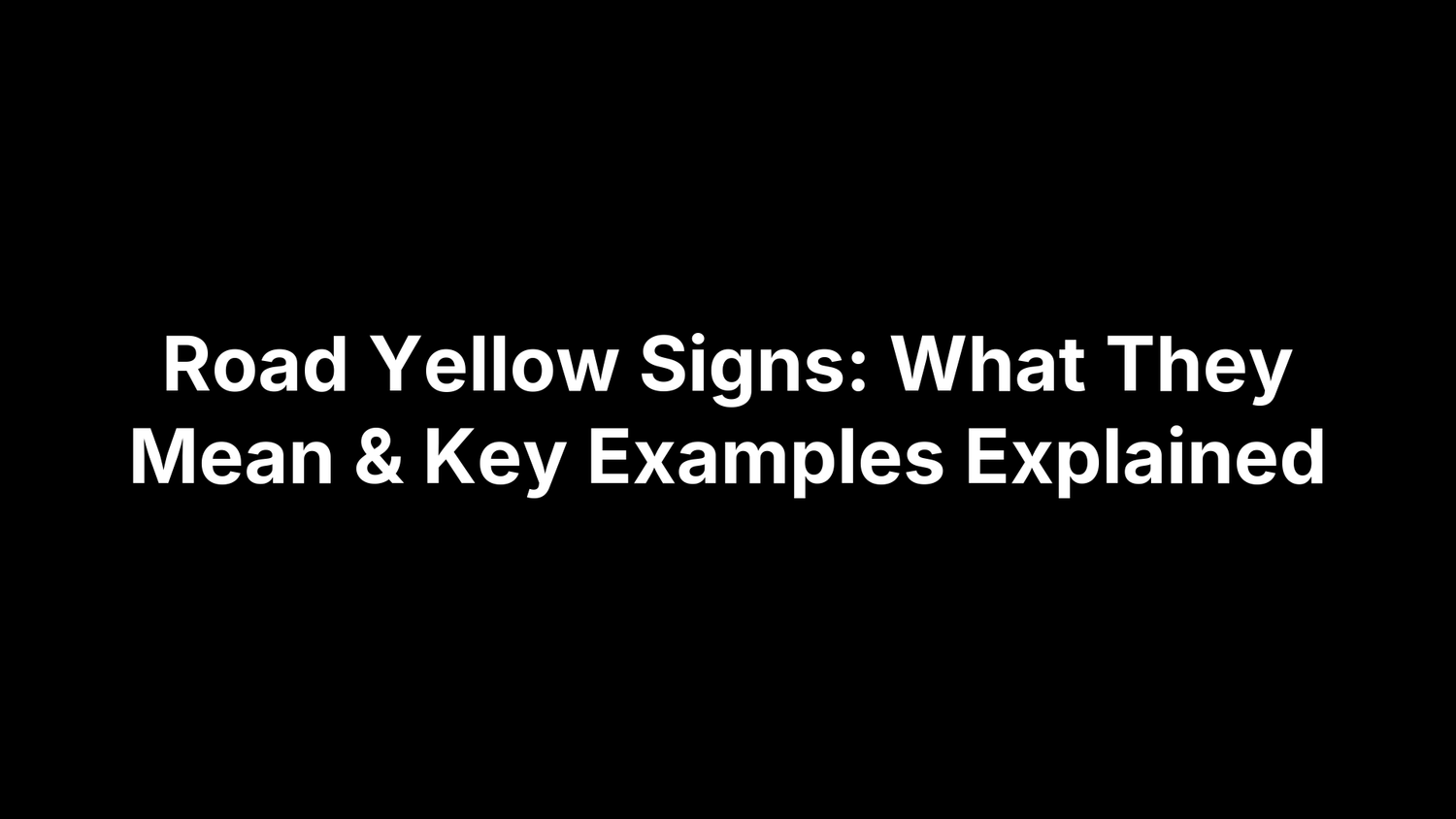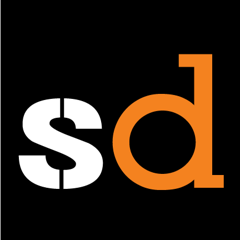Road Yellow Signs: What They Mean & Key Examples Explained
That flash of yellow on the roadside isn’t decoration—it’s a federally mandated warning that something ahead requires an extra measure of caution. Whether it’s a hidden curve, a school crosswalk, or a patch of loose gravel, the diamond or pentagon sign tells drivers to slow, look, and be ready. Ignore it and citations—or collisions—can follow.
This guide decodes the yellow palette. You’ll learn why federal standards pick that specific wavelength, how shapes and pictograms sharpen the message, and the safe reactions every driver should practice. If you’re studying for a DMV test, even better. We’ll walk through common examples—from merging lanes to deer crossings—then touch on upkeep, retroreflective materials, and where private roads can source compliant warning decals.
Fast Definition of Yellow Road Signs
Yellow road signs are the nation-wide shorthand for “heads-up.” Under the Manual on Uniform Traffic Control Devices (MUTCD), a yellow background paired with a black symbol or word warns of a specific hazard or change in conditions so the driver can adjust before reaching it. The classic diamond covers most general dangers, while a fluorescent yellow-green variant is reserved for schools, pedestrians, and bicyclists because it pops even more in low light.
| Color | Common Shape | Typical Message | Smart Driver Action |
|---|---|---|---|
| Standard Yellow | Diamond | Curve ahead, merge, deer crossing | Ease off throttle, scan, be ready to brake |
| Fluorescent Yellow-Green | Pentagon/diamond | School or pedestrian crossing, bike route | Slow to posted advisory speed, yield |
| Yellow with Black Border | Rectangle/Pennant | No passing zone, distance plaque | Keep lane, maintain safe following gap |
Why Drivers Need to Recognize Them
Failing to heed a yellow warning sign isn’t just bad form—it can cost you. Traffic citations, higher insurance rates, and liability after a crash often trace back to ignoring these cues. Memorizing them is therefore a must for DMV exams, daily commutes, and your legal duty to drive with due care.
The Science of the Color Yellow in Traffic Control
Human-factor studies show the eye’s rods and cones detect the 570–590 nm wavelength of yellow faster than almost any other hue, especially in peripheral vision. That “quick pop” of contrast against asphalt, trees, and sky is why the MUTCD assigns yellow to general warnings: the color buys drivers a critical half-second of reaction time. Add retroreflective sheeting and the signal is still readable at night, rain, or head-on glare.
| MUTCD Color | Primary Meaning | Typical Use | Driver Expectation |
|---|---|---|---|
| Red | Prohibition/Stop | Stop, Yield, Wrong Way | Full stop, do not enter |
| Yellow | General Warning | Curve, merge, deer | Slow, prepare |
| Orange | Temporary Warning | Work zones | Reduce, obey flagger |
| Green | Direction/Guidance | Exits, mileposts | Route choice |
| Blue | Services | Gas, hospital | Optional stop |
| Brown | Recreation | Parks, historic sites | Leisure facilities |
Retroreflective grades (Engineer, High-Intensity, Diamond) must return ≥ 7 cd/lx/m² of luminance at set test angles, ensuring yellow stays visible for its mandated 10-year service life.
History & Evolution of Yellow Warning Signs
Railroads first painted wooden “danger boards” yellow in the early 1900s. The 1935 MUTCD cemented the diamond shape; 1971 swaps wordy plaques for pictograms to aid non-English speakers. The 2009 edition tightened reflectivity rules, prompting widespread use of durable micro-prismatic films.
Fluorescent Yellow-Green vs. Standard Yellow
Introduced in the 1990s, fluorescent yellow-green reflects 50 % more light than standard pigment, piercing dawn, dusk, and rain. MUTCD restricts it to school, bike, and pedestrian warnings so drivers instantly connect the brighter hue with vulnerable users.
Shapes & Symbols You’ll See on Yellow Signs
If color tells you “warning,” shape narrows down the hazard before you can even read the picture. The MUTCD assigns distinct silhouettes so drivers can recognize critical warnings at highway speed—day or night, rain or shine.
- Diamond (◇) – The bread-and-butter shape for most roadway alignment or surface alerts: curves, hill crests, slippery pavement, and merging lanes.
- Pentagon (⬠) – Exclusively marks school zones and school crossings; the five sides mimic a schoolhouse to cue “kids ahead.”
-
Circle (◯) – Reserved for the advance railroad crossing sign (
RXR). The unique outline demands instant attention because rails present a high-risk conflict. - Pennant (▶) – A sideways triangle on the left shoulder means “No Passing Zone.” Its orientation points directly at the opposing lane you must not enter.
- Horizontal Rectangle (▬) – Used for advisory speed plaques or distance information when the message won’t fit on the main diamond.
Inside each shape, standardized black symbols—curved arrows, split lane lines, deer silhouettes—speak a universal language. Can’t place a new pictogram? Use the roadway context: approaching trees might hint at a wildlife crossing; dual arrows over a median likely signal two-way traffic resuming. When in doubt, ease off the gas—road yellow signs exist to give you reaction time.
Understanding Supplemental Plaques
Add-on plaques mounted beneath the main warning sign fine-tune the instruction. Words like “NEXT 2 MILES,” diagonal chevron arrows, or an orange advisory speed rectangle tell you the where, how far, or how fast so you can adjust well before the hazard begins.
Major Categories of Yellow Warning Signs With Examples
Memory experts—and most DMV study guides—agree: grouping road yellow signs by theme makes them stick. Think of the seven buckets below as mental flash cards; spot the shape and symbol on the road and your brain will already know the playbook.
Roadway Alignment Warnings
These diamonds prep you for bends that can throw off speed or sight-lines.
- Curve Ahead (single bent arrow)
- Reverse Curve (S-shaped arrow)
- Winding Road (triple bend)
- Hairpin Curve (270° arrow)
Slow before entering and match any posted advisory speed (45 mph → 35 mph).
Intersection & Traffic Pattern Warnings
Yellow signs here flag conflict points where vehicles converge.
- Crossroad, T-, or Y-Intersection
- Traffic Signal Ahead (signal head icon)
- Roundabout Ahead (circular arrows)
Ease off the throttle, cover the brake, and scan for merging traffic or changing lights.
Surface & Environmental Hazards
When the pavement itself is the problem, these symbols appear:
- Slippery When Wet (car with skid marks)
- Loose Gravel, Rough Road, Dip, Bump
- Flooded Roadway or Ice Bridge (regional variants)
Grip the wheel lightly, keep steering smooth, and avoid hard braking.
Pedestrian, School, & Bicycle Warnings
Fluorescent yellow-green makes vulnerable users impossible to miss.
- School Crossing (pentagon, walking children)
- Pedestrian Crosswalk (diamond, single walker)
- Bicycle Crossing / Shared-Use Path
Legally you must yield; many states require a complete stop when walkers are present.
People & Animal Crossing Warnings
Wildlife and farm life don’t follow traffic laws, so drivers must.
- Deer, Elk, Moose, Cattle, Horseback Rider
- Farm Machinery (tractor silhouette)
Dusk and dawn are high-risk; dim headlights to avoid startling animals.
Lane Control & Merging Warnings
These diamonds manage lane real estate.
- Merge Left/Right, Lane Ends, Added Lane
- Two-Way Traffic (opposing arrows)
Adopt the zipper merge at work-day speeds to keep flow smooth.
Railroad & Advance Signal Warnings
A round yellow “RXR” sign appears roughly 750 ft before tracks; rectangular “Exempt” plaques or flashing wig-wag lights may follow. Slow, look, listen—trains always have the right of way, and stopping distances dwarf any vehicle’s.
How to Read and Respond to Yellow Signs While Driving
Spotting a yellow sign is only half the job—the benefit comes from translating the warning into smooth, timely action. Experienced drivers rely on the SEE method: Search the roadway 12–15 seconds ahead, Evaluate the meaning of each sign in context (curve, kids, critters), then Execute the proper response before the hazard starts. That usually means easing off the accelerator, shifting your foot to cover the brake, and re-checking mirrors for tailgaters who may not have seen the cue.
Because road yellow signs announce conditions rather than commands, the safest response is proactive moderation. Slow before the curve, not in it; merge early if an “Lane Ends” diamond appears; and lower high-beam headlights near an animal-crossing symbol so you don’t spook wildlife. In rain, fog, or after dark, reduce your target speed by at least 5 mph and widen following distance to give the retroreflective warning more time to appear in your headlights.
Common Mistakes Drivers Make
- Blasting past advisory speeds and then braking mid-turn
- Treating fluorescent school warnings like optional suggestions
- Trusting a GPS cue over the physical “Road Narrows” sign
- Fixating on the sign itself instead of scanning the entire hazard zone
Practice Drills for New Drivers
- Create flash cards of common road yellow signs; quiz until identification is instinctive.
- During supervised drives, call out each yellow sign aloud and state the correct action.
- Use DMV practice tests that randomize symbol questions for realistic pressure.
- Plot a practice route with curves, merges, and crossings to rehearse real-time responses.
Visibility, Maintenance & Material Essentials
A warning sign is only useful if you can see it. The MUTCD requires every yellow sign to be covered with retroreflective film so headlights bounce back at night. Most agencies pick one of three grades:
- Engineer Grade (good for low-speed or indoor lots)
- High-Intensity Prismatic (standard roadside, 10-year life)
- Diamond Grade (freeway and critical crossings, 12+ years)
Age, ultraviolet fade, winter road salt, or even pellet-gun vandalism reduce brightness. When photometers show luminance dropping below the MUTCD threshold—about 50 cd/lx/m² at 0.2° observation—municipal crews schedule a swap-out before motorists lose that vital preview time.
Role of High-Quality Decals & Overlays
Instead of replacing a whole panel, many road departments slap a new micro-prismatic decal over the old face. It restores reflectivity, meets federal specs, costs less, and a two-person crew can finish the job in minutes.
DIY & Private Property Applications
Private roads, plant driveways, and HOA lanes still benefit from MUTCD-compliant warnings. Choose UV-stable vinyl with the right symbol size (minimum 24 × 24 in for diamonds) so deliveries, visitors, and liability insurers all see the same professional-grade caution cues.
Quick-Fire FAQs About Yellow Road Signs
Q 1. What’s the difference between yellow and orange road signs?
Yellow = permanent warning; orange = temporary work-zone warning.
Q 2. Are yellow signs enforceable laws or just suggestions?
They are advisory, but ignoring them can still trigger “driving too fast for conditions” tickets and liability in a crash.
Q 3. Why are some crossroad warnings rectangular, not diamond-shaped?
Rectangular yellow signs usually serve as supplemental plaques when extra words or symbols won’t fit on the primary diamond.
Q 4. How far in advance is a yellow warning sign placed?
MUTCD tables call for roughly 100 – 750 ft depending on speed limit; faster roads get more lead time.
Q 5. Can fluorescent yellow-green be used everywhere?
No. MUTCD restricts it to school, pedestrian, and bicycle warnings so drivers instantly associate the brighter hue with vulnerable users.
Wrapping Up Your Road-Sign Know-How
Yellow signs shout, “Caution—change ahead.” Shape and symbol zero in on the exact risk; your job is to slow, scan, and be ready. Need pro-grade warnings for a site or private lane? Check out Safety Decals’ MUTCD-compliant warning sign decals and keep every driver in the know.


